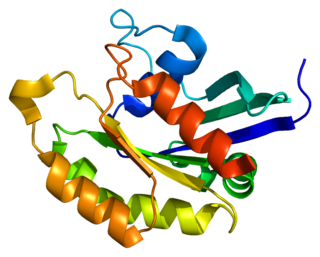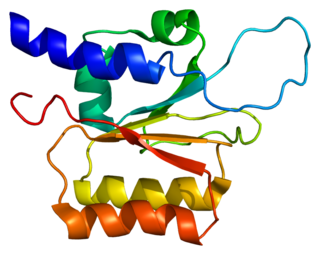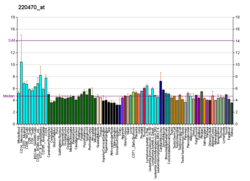
General vesicular transport factor p115 is a protein that in humans is encoded by the USO1 gene.

Syntaxin-6 is a protein that in humans is encoded by the STX6 gene.

Coatomer subunit alpha is a protein that in humans is encoded by the COPA gene.

Coatomer subunit epsilon is a protein that in humans is encoded by the COPE gene.

Syntaxin-5 is a protein that in humans is encoded by the STX5 gene.

Coatomer subunit beta is a protein that is encoded by the COPB2 gene in humans.

Synaptobrevin homolog YKT6 is a protein that in humans is encoded by the YKT6 gene.

Coatomer subunit gamma is a protein that in humans is encoded by the COPG gene. It is one of seven proteins in the COPI coatomer complex that coats vesicles as they bud from the Golgi complex.

Golgin subfamily A member 4 is a protein that in humans is encoded by the GOLGA4 gene.

Ras-related protein Rab-14 is a protein that in humans is encoded by the RAB14 gene.

Syntaxin-8 is a protein that in humans is encoded by the STX8 gene. Syntaxin 8 directly interacts with HECTd3 and has similar subcellular localization. The protein has been shown to form the SNARE complex with syntaxin 7, vti1b and endobrevin. These function as the machinery for the homotypic fusion of late endosomes.

Golgi SNAP receptor complex member 1 is a protein that in humans is encoded by the GOSR1 gene.

GRIP and coiled-coil domain-containing protein 2 is a protein that in humans is encoded by the GCC2 gene.

BET1 homolog is a protein that in humans is encoded by the BET1 gene.

Sec1 family domain-containing protein 1 is a protein that in humans is encoded by the SCFD1 gene.

Syntaxin-16 is a protein that in humans is encoded by the STX16 gene.

RAD50-interacting protein 1 is a protein that in humans is encoded by the RINT1 gene.

Golgi SNAP receptor complex member 2 is a protein that in humans is encoded by the GOSR2 gene.

Vesicle transport through interaction with t-SNAREs homolog 1A is a protein that in humans is encoded by the VTI1A gene.

Giantin or Golgin subfamily B member 1 is a protein that in humans is encoded by the GOLGB1 gene. Giantin is located at the cis-medial rims of the Golgi apparatus and is part of the Golgi matrix that is responsible for membrane trafficking in secretory pathway of proteins. This function is key for proper localisation of proteins at the plasma membrane and outside the cell which is important for cell function that is dependent on for example receptors and the extracellular matrix function. Recent animal model knockout studies of GOLGB1 in mice, rat, and zebrafish have shown that phenotypes are different between species ranging from mild to severe craniofacial defects in the rodent models to just minor size defects in zebrafish. However, in adult zebrafish a tumoral calcinosis-like phenotype was observed, and in humans such phenotype has been linked to defective glycosyltransferase function.



















